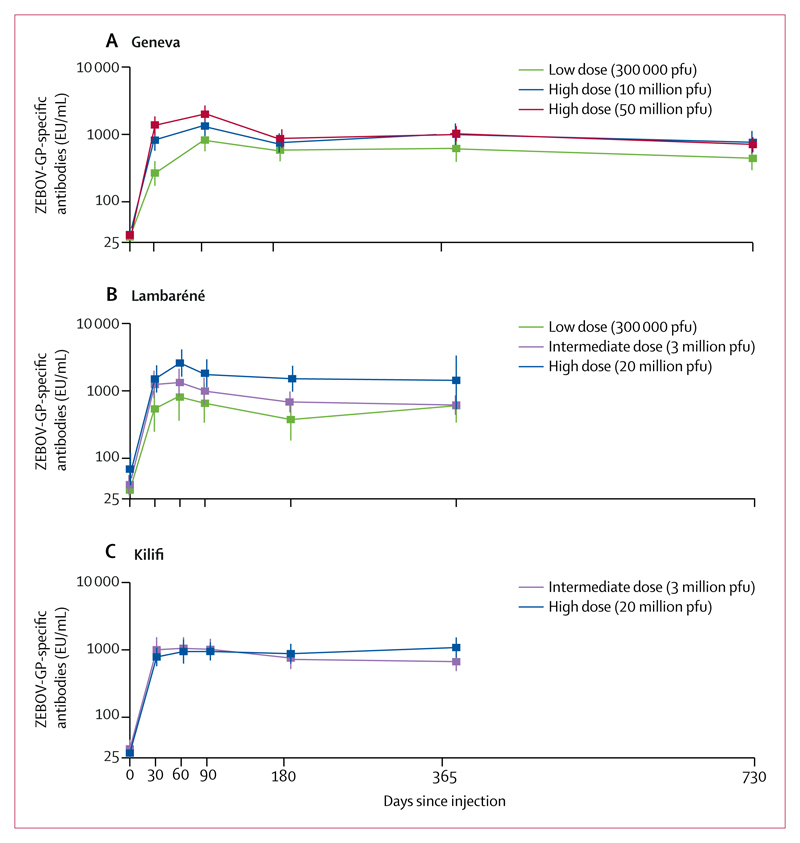Determinants of antibody persistence across doses and continents after single-dose rVSV-ZEBOV vaccination for Ebola virus disease: an observational cohort study.
The recombinant vesicular stomatitis virus (rVSV) vaccine expressing the Zaire Ebola virus (ZEBOV) glycoprotein is efficacious in the weeks following single-dose injection, but duration of immunity is unknown. We aimed to assess antibody persistence at 1 and 2 years in volunteers who received single-dose rVSV-ZEBOV in three previous trials. In this observational cohort study, we prospectively followed-up participants from the African and European phase 1 rVSV-ZEBOV trials, who were vaccinated once in 2014-15 with 300 000 (low dose) or 10-50 million (high dose) plaque-forming units (pfu) of rVSV-ZEBOV vaccine to assess ZEBOV glycoprotein (IgG) antibody persistence. The primary outcome was ZEBOV glycoprotein-specific IgG geometric mean concentrations (GMCs) measured yearly by ELISA compared with 1 month (ie, 28 days) after immunisation. We report GMCs up to 2 years (Geneva, Switzerland, including neutralising antibodies up to 6 months) and 1 year (Lambaréné, Gabon; Kilifi, Kenya) after vaccination and factors associated with higher antibody persistence beyond 6 months, according to multivariable analyses. Trials and the observational study were registered at ClinicalTrials.gov (Geneva: NCT02287480 and NCT02933931; Kilifi: NCT02296983) and the Pan-African Clinical Trials Registry (Lambaréné PACTR201411000919191). Of 217 vaccinees from the original studies (102 from the Geneva study, 75 from the Lambaréné study, and 40 from the Kilifi study), 197 returned and provided samples at 1 year (95 from the Geneva study, 63 from the Lambaréné, and 39 from the Kilifi study) and 90 at 2 years (all from the Geneva study). In the Geneva group, 44 (100%) of 44 participants who had been given a high dose (ie, 10-50 million pfu) of vaccine and who were seropositive at day 28 remained seropositive at 2 years, whereas 33 (89%) of 37 who had been given the low dose (ie, 300 000 pfu) remained seropositive for 2 years (p=0·042). In participants who had received a high dose, ZEBOV glycoprotein IgG GMCs decreased significantly between their peak (at 1-3 months) and month 6 after vaccination in Geneva (p<0·0001) and Lambaréné (p=0·0298) but not in Kilifi (p=0·5833) and subsequently remained stable at all sites apart from Geneva, where GMC in those given a high dose of vaccine increased significantly between 6 months and 1 year (p=0·0264). Antibody persistence was similar at 1 year and at 6 months in those who had received a low dose of vaccine, with lower titres among participants from the Geneva study at 2 years than at 1 year after vaccination (GMC ratio 0·61, 95% CI 0·49-0·77; p<0·0001). In multivariable analyses, predictors of increased IgG GMCs beyond 6 months included high-dose versus low-dose vaccination (Geneva p=0·0133; Lambaréné p=0·008) and vaccine-related arthritis (p=0·0176), but not sex, age, or baseline seropositivity (all p>0·05). Neutralising antibodies seem to be less durable, with seropositivity dropping from 64-71% at 28 days to 27-31% at 6 months in participants from the Geneva study. Antibody responses to single-dose rVSV-ZEBOV vaccination are sustained across dose ranges and settings, a key criterion in countries where booster vaccinations would be impractical. The Wellcome Trust and Innovative Medicines Initiative 2 Joint Undertaking.
Authors
Angela Huttner; Selidji Todagbe Agnandji; Christophe Combescure; José F Fernandes; Emmanuel Bache Bache; Lumeka Kabwende; Francis Maina Ndungu; Jessica Brosnahan; Thomas P Monath; Barbara Lemaître; Stéphane Grillet; Miriam Botto; Olivier Engler; Jasmine Portmann; Denise Siegrist; Philip Bejon; Peter Silvera; Peter Kremsner; Claire-Anne Siegrist
External link
Publication Year
Publication Journal
Associeted Project
Microbiology or Immunology
Lista de serviços
-
As antisense RNA gets intronic.As antisense RNA gets intronic.
-
Androgen responsive intronic non-coding RNAs.Androgen responsive intronic non-coding RNAs.
-
Conserved tissue expression signatures of intronic noncoding RNAs transcribed from human and mouse loci.Conserved tissue expression signatures of intronic noncoding RNAs transcribed from human and mouse loci.
-
The intronic long noncoding RNA ANRASSF1 recruits PRC2 to the RASSF1A promoter, reducing the expression of RASSF1A and increasing cell proliferation.The intronic long noncoding RNA ANRASSF1 recruits PRC2 to the RASSF1A promoter, reducing the expression of RASSF1A and increasing cell proliferation.
-
Antisense intronic non-coding RNA levels correlate to the degree of tumor differentiation in prostate cancer.Antisense intronic non-coding RNA levels correlate to the degree of tumor differentiation in prostate cancer.
-
Insight Into the Long Noncoding RNA and mRNA Coexpression Profile in the Human Blood Transcriptome Upon Leishmania infantum Infection.Insight Into the Long Noncoding RNA and mRNA Coexpression Profile in the Human Blood Transcriptome Upon Leishmania infantum Infection.
-
Long non-coding RNAs associated with infection and vaccine-induced immunityLong non-coding RNAs associated with infection and vaccine-induced immunity
-
Comparative transcriptomic analysis of long noncoding RNAs in Leishmania-infected human macrophagesComparative transcriptomic analysis of long noncoding RNAs in Leishmania-infected human macrophages
-
SARS-CoV-2 Selectively Induces the Expression of Unproductive Splicing Isoforms of Interferon, Class I MHC, and Splicing Machinery Genes.SARS-CoV-2 Selectively Induces the Expression of Unproductive Splicing Isoforms of Interferon, Class I MHC, and Splicing Machinery Genes.

